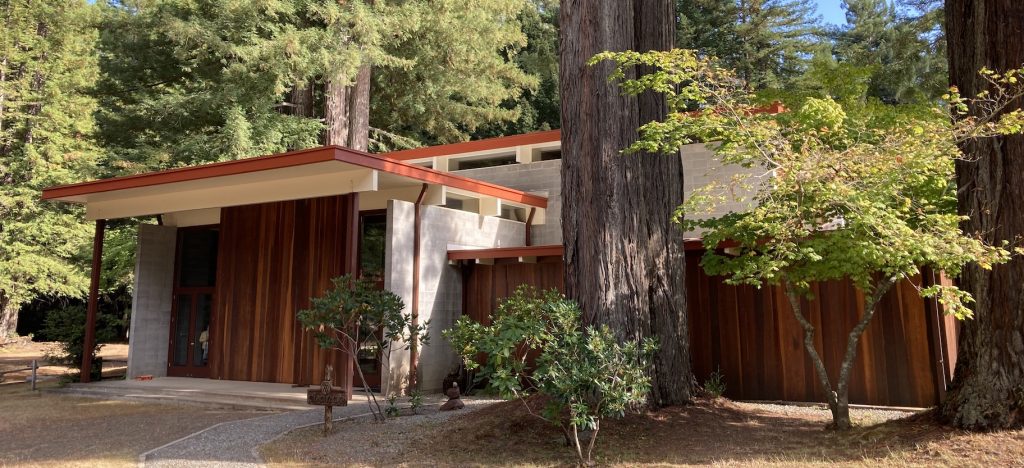Deep in the redwood forests of Mendocino County along the Lost Coast of California, a small but remarkable community of Trappistine nuns has been quietly living for 60 years.
Founded in 1962 by sisters from the Abbey of Our Lady of Nazareth in Belgium, the monastery of Our Lady of the Redwoods is a special place where the ancient monastic traditions of prayer, silence, hospitality, and hard work have found a distinctively American home.
My first visit to Redwoods Abbey was in 1995. In grad school in Berkeley, I’d taken a memorable class on Thomas Merton, the Trappist monk who was one of the most influential American Catholic writers of the 20th century, and who interpreted monasticism to generations of Americans. I knew the abbey was the last place he had visited in the U.S. before traveling to Asia, where he met his untimely death.
A long, scenic drive from Berkeley on the winding Highway 101 through the towering redwoods brought us to the monastery. It’s no Gothic pile, but rather a group of small and simple buildings, with the austere monastery church at its center. Inside the buildings, there are polished concrete floors and plain wood furnishings. Sunlight streams in through large glass windows, filtered through the branches of giant sequoias that were saplings when the Cistercian order was established in Cîteaux, France, almost 1,000 years ago.
On that first visit I was fortunate to meet three of the original founding sisters from Belgium, who had all been young nuns when Merton visited, and whom Merton mentions in the “The Asian Journal of Thomas Merton” (New Directions, $18.95). Our conversations were short, but I’ve remembered them all throughout the years. Cistercian wisdom rang out in how the sisters talked about prayer and Scripture, the monastic vocation, and their particular care for the place they lived in.
“In Europe, we tend to see God in history,” one of them had told me. “But here, it is easier to find God in nature.”
They struck me as remarkable people, women who understood the workings of the human mind as well as they did as the mystery of the soul. I never forgot them but had treasured those encounters.
This summer after 27 years, I returned to Redwoods Monastery for a weeklong retreat. It was a chance to pray and join in the sacred silence. Half a lifetime later, I am welcomed again with classic monastic hospitality. Little has changed, but only one of the original Belgian sisters remains, Sister Veronique, a strikingly luminous and humorous 90-year-old. The American sister I remember as a young nun has succeeded Sister Myriam Dardenne, OSCO, the Belgian foundress, who is buried there.
The community remains small: demanding monastic life is not for everyone. But “the work of God” continues: silence, prayer, and simplicity in all things. The psalms are sung day and night, expressing and shaping the nuns’ inner world.
This visit, I am struck less by the remarkable architecture (the chapel, I think, is one of the most beautiful modern churches I have ever seen) and more by the dramatic environs of the ancient redwoods. It is rare to be a part of such a pristine world: walking along the roads surrounding the monastery, there is no litter and few signs of 21st-century human habitation.
Most of the time, there is near absolute silence, the only sounds being the wind whispering through the trees, chirping birds, and the occasional passing car. That external quiet is mirrored by the internal silence of the monastic life. The nuns’ work in the garden and kitchen is interspersed with the occasional ringing of the bell calling the community to chant the psalms together several times in the day and night.
This mosaic of soft sound and the rhythm of work and prayer make it easier to listen for the voice of God.
On my first night of retreat, with my mind still full of the busyness of my current ministry, I woke at 3 a.m. in the concrete block guesthouse. I rose from my bed and wandered outside. The sky was a kaleidoscope of bright stars — more than I had ever seen. Quite literally I gasped at what seemed at first glimpse more like a hallucination than reality: the Milky Way unfurled in all its glory.
Psalm 8 leapt unbidden to my mind:
“When I see your heavens, the work of your fingers,
the moon and the stars, which you set in place —
What is man that you are mindful of him,
and a son of man that you care for him?”
The night sky put me firmly in my place. Whether we see them or not, the stars are there. They show forth the glory of God.
The praise of God by the Church and creation alike continues day and night. It’s a blessing, however rare or brief, to join with it in whatever way we can.

